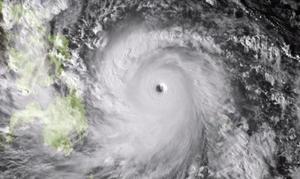Disaster losses2013 natural catastrophes dominated by extreme weather in Europe, Supertyphoon Haiyan
Exceptionally high losses from weather-related catastrophes in Europe and Supertyphoon Haiyan dominated the overall picture of natural catastrophes in 2013. Floods and hailstorms caused double-digit billion-dollar losses in central Europe, and in the Philippines one of the strongest cyclones in history, Supertyphoon Haiyan, resulted in a human catastrophe with over 6,000 fatalities.

Supertyphoon Haiyan crashing into the Philippines // Source: augie.edu
Globally, losses from natural catastrophes in 2013 were somewhat more moderate: the direct overall losses of around $125 billion and insured losses of around $31 billion remained below the average figures of the past ten years ($184 billion and $56 billion). Regrettably, in a total of 880 natural catastrophes (average of the past ten years: 790), more than 20,000 people were killed. This meant that the death toll was higher than in 2012, but significantly below the average of the past ten years (106,000).
“Several of the events of 2013 illustrated how well warnings and loss minimization measures can restrict the impact of natural catastrophes. In the case of the most recent winter storms in Europe, for example, the losses remained comparatively low”, said Torsten Jeworrek, Munich Re Board member responsible for global reinsurance business. “At the same time, events like those in the Philippines show the urgent need for more to be done in developing and emerging countries to protect people better. This includes more stable buildings and protection facilities, and insurance programs — also with state backing — to provide those affected with financial assistance after a disaster.”
Europe: June flooding was the yearʼs most expensive catastrophe
Munich Re reports that the costliest natural catastrophe of the year in terms of overall economic losses was the flooding in southern and eastern Germany and the neighboring states at the beginning of June. Overall losses totaled $15.2 billion (€11.7 billion), while insured losses came to $3 billion (€2.3 billion).
The flooding was triggered by so-called Vb weather conditions, in which a strong low-pressure system drew warm moist air from the Mediterranean across the Black Sea and carried it in a wide arc around the Alps as far as Germany. When this met with cold air masses, the result was days of heavy rainfall on already saturated ground. In some cases, precipitation of 400 liters per square meter in only a few days was measured. On many rivers, the subsequent flooding set new records, such as in Passau at the confluence of the Danube, the Ilz, and the Inn, where the flood waters reached the highest level since 1501. In other parts of the country, such as on the Danube near Deggendorf in Bavaria and the Elbe near Stendal in Saxony-Anhalt, dykes broke, allowing the flood waters to spread for kilometers across low-lying areas.
